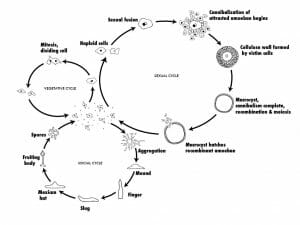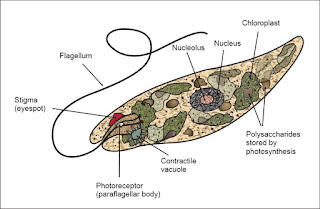Study of Amoeba | General characters and classification
Study of Amoeba with General character and Classification
Defination of Amoeba
An amoeba is a highly mobile, single-celled eukaryotic organism. It typically belongs to the protozoa of the kingdom, and moves in an "amoeboid" fashion. As such, microbiologists often use the word "amoeboid," to refer interchangeably to a specific type of movement and amoebae. Ironically, amöbae are not a distinct taxonomic group but rather distinguished by their "amoeboid" movement rather than distinct morphological characteristics. Moreover, even members of the same species can appear dissimilar. Amebae species can be found in all major eukaryotic lineages, including fungi, algae, and even animals.
Habit and habitat-
Amoeba proteus occurs abundantly in the depths of ponds, ditches. It is always found alongside aquatic vegetation.
Structure:
The body of amoeba proteus resembles a blob of an irregular jelly and measures about 600 micra in average diameter .
The cytoplasm is differentiated into ectoplasm and endoplasm.
The ectoplasm is less extensive, gel in the nature and non-granular though in electron microscopy it shows threads and particles of unknown significance. The endoplasm is divisible into two parts—the stiff region beneath the ectoplasm is called plasmagel and an inner-fluid part called plasmasol. The plasmasol includes various organelles and inclusions.
Organelles of Amoeba Proteus-
1. Contractile vacuole: Single, large and transparent; gradually increases in size and ultimately bursts.
2. Food vacuole: One or more spherical vacuoles containing water and food particles at different phases of digestion.
3. Water vacuole: Several occur as perfectly transparent colourless drops which do not change in size.
4. Food storage: Numerous granules of the nature of fats and carbohydrates which are recognised by using special staining methods.
5. Mitochondria: These are present in the form of rods or dots and are recognised by special stains.
Locomotion of Amoeba Proteus:
Locomotion in amoeba proteus is creeping in nature and is dependent upon an intimate and direct contact with a substratum. Creeping in amoeba involves the production of finger-like projections called the pseudopodia and the movement is called amoeboid movement.
During locomotion in Amoeba proteus one or more blunt finger-like pseudopodia are formed in the direction of movement. The projection grows more and more by accumulation of cytoplasm from other parts of the body.
In some cases Amoeba proteus has been seen to walk on the tips of the pseudopodia. A good many theories have been advocated to explain the mechanism involved in the formation of a pseudopodium. Mast (1925) has given a thorough and detailed description of pseudopodia formation.
The Amoeba's body, according to Mast, consists of four parts the thin and elastic plasma membrane, the plasmagel, the plasmasol, and a hyaline layer between the membrane and the plasmagel. Actions and interactions between those four parts result in the formation of pseudopodium.
Respiration in Amoeba Proteus:
Oxygen dissolved in water enters the body through the general surface of the body, and oxidized car-bon dioxide passes through the surface of the body through the diffusion process.
Excretion in Amoeba Proteus:
By-products of dissimilation are urea and uric acid. They along with excess salt in solution, pass out of the body through plasmalemma by a physical process called diffusion.
Reproduction in Amoeba:
Their are 4 types of reproduction amoeba shows-
1.Binary fission
2.Multiple fission
3.Spore formation
4.Sexual reproduction
Binary Fission
By far the most common form of asexual reproduction employed by amoebae is binary fission. In preparation for reproduction, the amoeba will withdraw its pseudopodia and form a spherical shape. Mitosis is observed in the nucleus, and the cytoplasm divides at the center of the cell and separates, forming two daughter cells. Since this process involves simply copying the genetic information to form a second cell, the two resulting daughter cells are identical clones of the parent cell. Thus, the nucleus is absolutely essential for this form of reproduction. This has been verified in experiments involving slicing an amoeba in half or extracting the nucleus from the amoeba. In both situations, the cell eventually dies without a nucleus.
Multiple Fission and Encystment
Under conditions of food shortages, amoebae will reproduce via multiple fission. This process involves the production of multiple daughter cells by:
- the pseudopodia being retracted and the amoeba forming a spherical shape;
- the amoeba secreting a substance that hardens and encapsulates the cell, forming a cyst (encystment);
- the amoeba, protected by the cyst, will undergoing mitosis several times, producing multiple daughter cells;
- when favorable conditions return, the cyst wall bursts, releasing the daughter cells. Within a host, the amoeba will undergo encystment as a means of protection against desiccation as it travels through the colon, which ensures its survival outside of the host.
Spore Formation
Solitary haploid amoebae (known as myxamoebae or “social amoebae”) reside on decaying vegetation (e.g., logs), eat bacteria, and reproduce asexually via binary fission as described above. However, unlike the amoebae, which undergo encystment when the food supply becomes exhausted, tens of thousands of myxamoebae will fuse, forming a moving stream of cells converging at a central location. It is at this region that the cells stack on top of each other and form a conical mound termed a “tight aggregate”. Next, a tip rises from the top of the conical mound and the tight aggregate folds to produce a mobile “grex” (also termed a pseudoplasmodium or slug), 2–4 mm in length and surrounded by a slimy substance. The grex will then migrate towards an illuminated area, where it will differentiate into a fruiting body composed of a tubed stalk (approximately 15%–20% of the entire cellular population) and spore cells. This process involves the secretion of an extracellular coating and the extension of a tube through the grex by prestalk cells located in the anterior of the grex. As the prestalk cells differentiate into stalk cells, they create vacuoles and become enlarged. This serves to lift the prespore cells in the posterior section of the grex. The elevated prespore cells differentiate into spore cells and disperse, each representing a new myxamoeba, while the stalk cells die.

Sexual Reproduction
Myxamoebae are also unusual in being able to reproduce sexually, too. This happens as two myxamoebae join together to form a gigantic cell. The massive cell then envelops all other cells in an aggregation of myxamoebae. The giant cell must encyste itself after digestion of all its relatives, then undergo meiosis and mitosis separation multiple times under the cyst's protective cover.
The cyst will burst when sufficient environmental conditions are met, releasing new myxamoebae. Because this process involves meiosis and the two amoebae genetic information, the resulting daughter cells will be genetically distinct from the parent cells.
Nutrition in Amoeba-
General Characters of Amoeba-
1.Amoeba belongs to kingdom protozoa and is a eukaryote.
2.Amoeba is a unicellular organism with a nucleus and granular endoplasm. It lacks mitochondria and undergoes anaerobic respiration.
3.Amoeba does not have any definite shape and size varies about 2-3 microns.
It is mostly found in still or slow-moving water bodies.
4.Amoebas are present as both free-living and parasitic types.
5.The movement of amoeba is typical and termed as amoeboid locomotion which is done through its pseudopods.
6.Amoeba asexual reproduction is through binary fission and sexual reproduction is through meiosis.
Classification Of Amoeba proteus -
Phylum- Protozoa
Sub-phylum- Sarcodina
Superclass- Rhizopoda
Class-Lobosa
Order- Amoebida
Genus- Amoeba
Species- proteus














Comments
Post a Comment